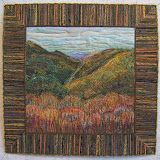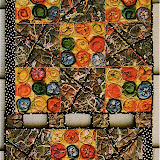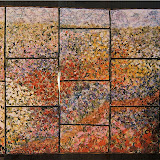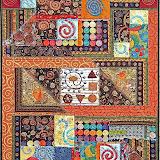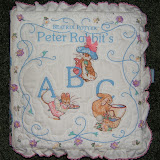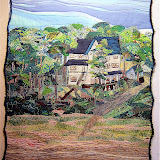Thursday, May 26, 2011
I've enjoyed the weekly themed contests over at the "Quilting Gallery." It's been fun to see the quilts submitted from all over the world and then to follow my favorite throughout the weekend. On occasion I've entered to share my quilts when I have one that's suitable for that weeks theme. The subject for this week is "wildlife" and I've entered this one ...
Toonga - 37"x 40"
Toonga (an African word for adventure) was created in 2002. It is the second piece in my African series. The fragmented images symbolize my perception of Africa ... from a jungle safari to structural and native patterns. I'm fascinated by the fact that a herd of elephants can move so quietly that their presence isn't known until you see them. They're moving unobtrusively through the shadows and foliage across the midsection of this quilt.
Soooo ... click on over the "Quilting Gallery" ... take a look at this weeks collection and vote for your favorite.
Monday, May 23, 2011
Smocking - "the end"
This is the last post about my smocking days ... the days when I applied that stitchery to art pieces ... the days when I was studious about color.
Shadowed Hues - 14" x 13"
The one above was juried into The National Needlework Association show that traveled the United States for one year in the 1980's. Here's a close-up of the trellis stitch cross-over patterning.
Rows of the pure hues are laid on top of and off-set over rows of muted tones. I used only DMC floss. It was a challenge to blend within a color, let alone to blend into the next hue, even though DMC had lots and lots of colors from which to select.
This one hangs above the coat rack in our front entrance.
Point-Counter-Point - 19" x 9"
My color objective for this one was to combine yellow and violet, whereas, the one at the top was focused on orange and violet. As I recall, both of these were made while I was taking a year-long correspondence color course through the Embroidery Guild of America.
I loved manipulating the smocked fabric into shapes.
Silk Fan - 20" x 14" (frame)
The thread, fan fabric, and background are all silk. I just happened to have that mother-of-pearl button to finish the bottom. The gold leaf frame was built especially for this piece by a friend's husband.
As I recall, my color objective was to keep it monochromatic by shading from pink to coral. The rows of trellis stitches were worked in a diagonal pattern across the fabric ... more playing.
This is the last smocked art piece that I created.
Untitled - 16" x 9"
I had covered a shadow box frame that was made for this piece with the same heavy gray linen that I used as the foundation fabric for the smocking. However, I didn't like the joins at the corners so it never got mounted. Here's a photo of it in process.
Then I had the idea twenty years ago to combine this smocked panel with quilted piecing. I worked on that for most of a week long workshop with Nancy Halpern at Arrowmont Design & Craft School. I had so much trouble with cutting the parallelogram shapes for the piecing that I decided I really needed to learn the craft of quilting ... that's when the current leg of my creative journey began. Before it's over, I may get this piece finished ... all the materials are wrapped up and stored away.
I thank all of you who have left comments in this series of posts. I very much enjoyed my years of smocking. During that time of stitching and teaching I learned so much about color and design. Without that experience I would not be where I am today in this amazing journey of making art.
PS: To see all the posts about smocking, click on the "smocking" label at the end of this one.
Tuesday, May 17, 2011
"Creative Smocking"
...is another book that features my work.
One of my pieces is featured in the introduction to the book.
The combination of the lattice style smocking complemented the crinkled texture of the skirt fabric. It was one of my favorite outfits.
Another garment in this book was one of my early quilting projects.

Didn't a lot of quilters make their own version of "Jacket Jazz"? I had fun making it ... and one for a friend ... as well as helping my mother make hers. That was the first appearance of Elvis in my work. The only place I didn't fracture his image was inside the pocket. He's in the flying geese pattern down the front (I called it the flying Elvi) and his face is on a fish (called Wanda) on the sleeve above the smocked inset.
The last five years of my teaching focused on color and design rather than techniques. During that time I had applied smocking to art pieces. "Convex Dimensions" was the first.
I've previously blogged about the pieces pictured above and below here and here.
This is one of the last smocked art piece that I created.
The photo taken of the book doesn't do it justice, so here's another picture.
I just now noticed that the published one is upside down.
When we moved to Tennessee twenty years ago a new spread for our bed was needed in our bedroom. Soooo... I smocked a raw silk one.
It was beautiful and elegant in that room. However, it didn't work well with dogs jumping on and off the bed. Consequently, I switched to a washable duvet cover on a down blanket. We've gone through two of those, while the smocked spread is safely stored away.
I thought you'd like to have a closer look at the cape pictured on the cover of this book. It was designed and smocked by Sarah Douglas. It's made of soft wool flannel and embellished with many variations of the chain stitch.
There are many other wonderful projects presented in this book written by Chris Rankin published by Lark Books in 1997. For those of you who are interested, here's it's number: ISBN 0-87374-33-7
Wednesday, May 11, 2011
More Smocked Clothes
I'm glad to hear this little memory trip hits a cord with a number of you. For those of you who are interested, here are a few more pictures of me wearing clothing that was smocked.
I especially liked blouses. The red gingham one is in the book I wrote about in the last post, as is the cocktail dress. The one pictured on the right is a gauze fabric smocked with a white cotton twist thread. I think it was crochet yarn. The one below is made of heavy cotton muslin and smocked with cotton floss.
I left the partial newspaper article in the scan out of our family scrapbooks. Click on it and enlarge if you'd like to read a bit more about what I was doing and saying about smocking back then.
The stitching instruction for the design on this peasant blouse was published so others could make it, too.
I liked to tuck those blouses in rather than wearing them loose. My trick was to tuck all that fullness into the top of my pantyhose for a sleek look. Mmmmm ... where would all that fullness hide in today's under garments?
I also liked sundresses and am glad I wore them when I could. Back then I never dreamed the toll that time would take on an aging body.
And lastly, I thought you may like to see the back of this dress as well as the hood. The fabric is a pale green slubbed cotton and the smocking was stitched with Danish Flower Thread.
Ethnic clothing is making a comeback. I see so many garments in the ads and catalogs that I would've worn "back when". I still have most all those garments. Think I may dig them out of storage to see if any of the young women in my family are interested in giving them another "go around".
Tuesday, May 10, 2011
More Smocking
While I'm on the subject, I'd like to share more of my smocking that was published in this book back in 1982 ...
It was written by my sister-in-law, Dianne, who had introduced me to smocking. I had taken to this stitchery like a duck to water. I found it much more interesting to do than counted cross-stitch, as well as much faster to complete a project than needlepoint canvas work and crewel embroidery. By the time this book was published I had been teaching smocking for a few years. I found ways to incorporate it into the ethnic influenced style of clothing that I wore, since I had no daughters to smock for. Just about all those garments found their way into this book.
It was a peasant blouse Dianne was stitching that initially piqued my interest. My first smocking was done on the blouse I wore on the cover of my workbook. I loved that style as well as doing the smocking, so I made a number of them. This one features a design concept that I developed ... plaid smocking.
These two nightgowns are variations of the round yoke style for the raglan sleeve style of the peasant blouse.
The adjacent page has the "map" for the stitch placement on graph paper to make that particular design. Graphing of smocking designs was another concept that I developed.
The cocktail dress in the center is one I made of a silky synthetic jersey knit. It was the first project to which I added beads and stitched with a thick shiny synthetic thread ... a departure from 3 strands of cotton floss on cotton fabric.
The one on left I made as a wedding dress for a friend's second marriage. It's made of silk satin backed crepe and stitched with silk twist thread.
Dianne and I both made dresses from the published pattern she designed. They have hoods that you can't see in the photos. Fun to wear!
I designed and constructed the sundress on the left for my friend, Alicia. She did the smocking, though. The one in the center was one of my favorites and I wore it for several summers. The pretty one on the right was my experiment in coordinating a smocking design to the border print in the cotton fabric.
I wore this gingham blouse with a denim skirt or white slacks.
I still have the child's blouse and would've liked my granddaughter to wear it. However by the time it fit her, she had developed a different taste in clothes.
Here are thumbnails of those garments in color ...

It was fun for me to revisit this part of my life through this book. I hope you enjoyed it, too.
Monday, May 09, 2011
Smocking - A Trip Down Memory Lane
The post I wrote about being happy to be a mother started a trip down memory lane. In retrospect I appreciate that it was a beneficial time to be a mother. Society accepted broader roles for women, plus many of us had the choice of staying home with the kids or working outside the home. I attribute satisfaction with my motherhood to being an at home mom with the luxury of having time, money, and energy to pursue my interest in needlework. The beginning of my serious involvement was when the boys were about 8 and 10 years old. Initially, it was teaching classes around my dining room table. Eventually, that expanded to evening courses at the local college campuses and then to workshop and lecture tours around the country and Canada. As the saying goes, "If Mama ain't happy, nobody's happy". The balance of my home life and involvement in the needlework world made me happy.

During my "prime time" years (mid 70's through the 80's), English smocking dominated my life. I taught the technique in 6-week long classes on three Milwaukee Technical College campuses. The photo above is the cover and introduction page of the book I wrote. It's in a workbook format that reflects the 6-week session for beginners. I had intended to write another for the advanced class, Series II, but never did. My husband and best friend posed in the photos with me to save on modeling fees.
During that time I also wrote booklets as well as designed kits (Christmas ornaments and Easter eggs) and clothing patterns for smocking. Those were produced and published by a company called Little Miss Muffet. This one for doll clothes is based on the most popular smocked outfits for children.
The models are the first two dolls in what ended up being an extensive collection. I named them after my niece and nephew who's mother, Dianne Durand, had introduced me to this beautiful needlework skill. Dianne owned and ran the Little Miss Muffet company. She and I along with several other young mothers founded the Smocking Arts Guild of America* (SAGA).
There were also two books that included the patterns for doll clothes. "Book I" featured the "Kalico Kid" doll family.
The storybook tale of the Kalico family takes place during the Great Depression. In the story a well-off aunt sends a box of cast-off clothes to her sister, which was my inspiration for making these garments.
"Book II" features the Fischer Price "Best Friends" and Sasha dolls that were popular back then ...
The back cover featured the matching dresses I had designed and made for the little girl who lived next door to us. Here's the centerfold picturing all the outfits offered.
It pleases me to see these books listed on eBay now and then. It's a secondary market, because they haven't been published for many years ... about as many years as I haven't been smocking.
*I'm happy to report that SAGA is still going strong even though none of us founders are involved. The way I see it, that's akin to good parenting ... we each gave many years of work and devotion to establish a good foundation so it could survive and thrive into the future.
*I'm happy to report that SAGA is still going strong even though none of us founders are involved. The way I see it, that's akin to good parenting ... we each gave many years of work and devotion to establish a good foundation so it could survive and thrive into the future.
Saturday, May 07, 2011
Happy Mother's Day!
I'm happy! I've been a happy mother since my older son was born back in 1966 and my younger one two years later.
1968
I was happy with my boys throughout their childhood.
1978(?)
Even through their teenage years.
1985
I very much enjoyed their young adulthood.
1991
I'm happy being the mother of these two fine grown men.
2010
I'm happy to be mother-in-law to their wives.
2009
And "Granellie" to their children.
2009
I wish all of my friends who are also mothers and my daughters-in-law a joyous and peaceful Happy Mother's Day.
Wednesday, May 04, 2011
Lake #69
It's been a while since I've added to my series of 100 lake quilts.
Lake #69 - 19"x 14"
All the fabric pieces it's composed of came from the scrap bag on the right in this photo.
There are quite a few people who save their scraps for my "ortwork" quilts. This bag is special in that it came to me through my friend, Tone Haugen-Cogburn. These scraps are from her student's projects made in the workshop she recently taught at the John C. Campbell Folk Art School in North Carolina. Collecting them for me was initiated by Julie who reads this blog. To see the projects from which these scraps came, as well as photos of the school grounds, go to Julies photo album.
The two boxes on the left in the above photo have scraps separated out from the bag for two projects. The bottom one is for an upcoming project that needs larger pieces, while the top one has the size and color of scraps to make lake pieces. Here's the state of this lake piece midway through the process. Yarn and wool roving are added to the scraps to give definition to the clouds and crests on the waves.
It was made as a house present for friends who used to live near Lake Michigan. We spent the night with them in Hendersonville, North Carolina on our way to South Carolina.
That spot isn't where it's going to "live". We took down an art piece so I could show her how to hang "Lake #69".
We stopped in Asheville to visit our favorite galleries, New Morning and the Blue Spiral ... and yes, we bought something, but it's still in its wrapping so there's no photo. But I do have a picture of a car we saw in traffic on the way from one gallery to the other.
There was a stoplight, so I got to speak to the driver. She had "beaded" it herself. What a hoot!
Subscribe to:
Posts (Atom)







































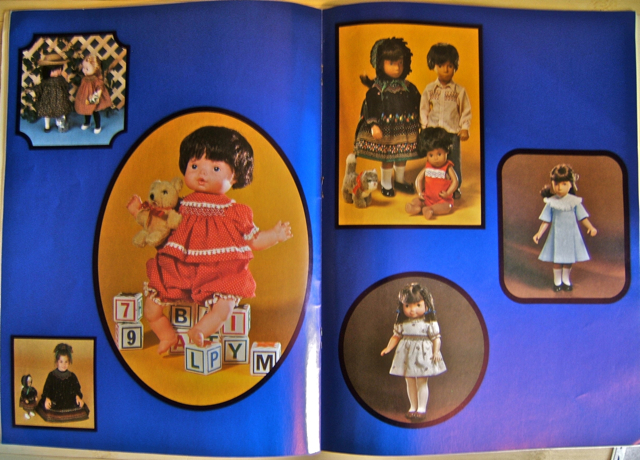















 Fabric Bird Sculpture Pattern
Fabric Bird Sculpture Pattern



